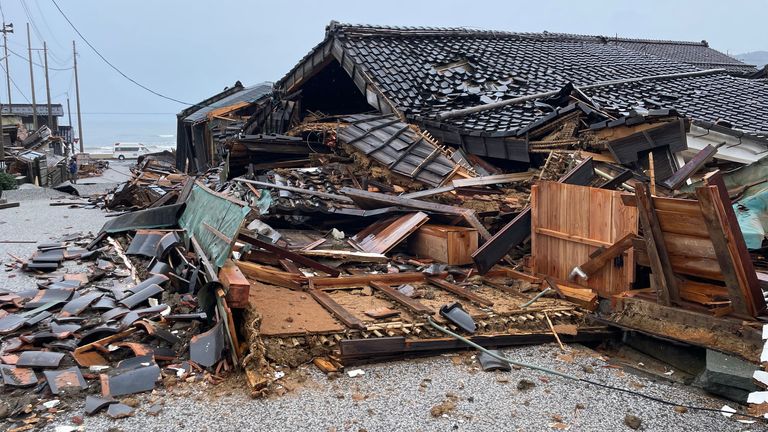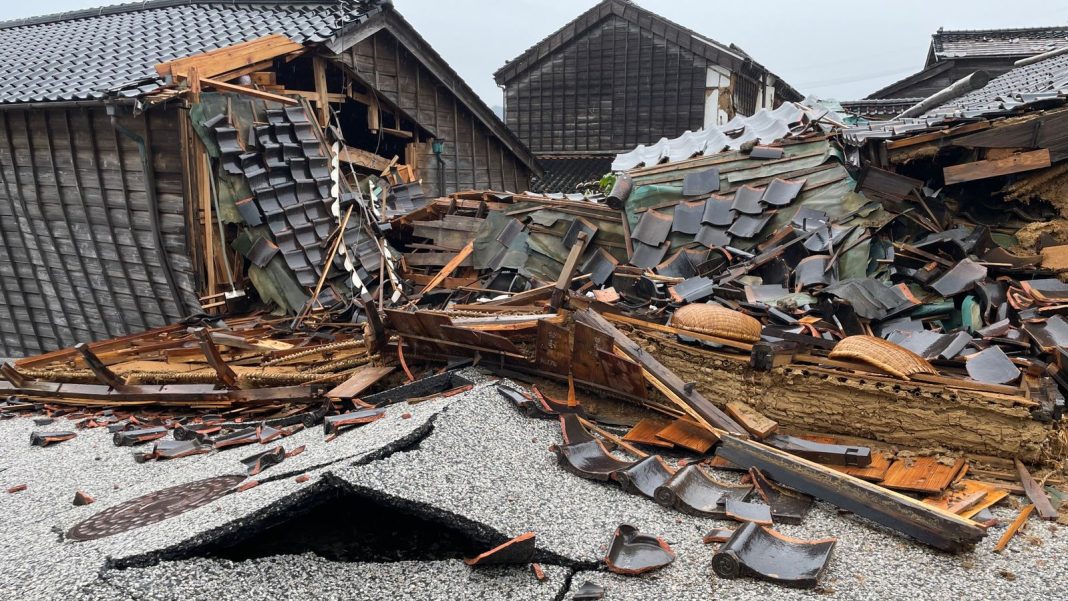The roads that snake up the Noto peninsular get worse the further we drive.
What starts as a few small, irregular cracks turn into sizeable craters and fissures. In some places the concrete has totally buckled, making the route impassable.
It is no wonder rescue efforts have been rendered so complicated, and the full scale of the damage and casualties is still extremely unclear.
Indeed, some of the worst-hit areas remain almost inaccessible unless you have an army truck, or better a helicopter.
But you don’t need to be at the epicentre of this disaster to clearly see the destruction it has wrought.
That is plainly evident in village after village we pass.
Entire streets of old traditional houses are damaged or destroyed in the village of Kuroshima

Some of the worst-hit areas remain almost inaccessible
In one, entire streets of old traditional houses are, at best, damaged beyond what’s habitable, surrounded by shattered glass and fallen beams and, at worst, have completely collapsed.
There are clues in the rubble as to the traditional lives uprooted here.
In one destroyed home, wicker baskets lie scattered atop the fallen wooden walls, reinforced with just clay.
A lot might have been said about how good Japanese infrastructure is in the face of such quakes, but these homes didn’t stand a chance.


It’s here we meet Mamiko Nakatani. She is taking shelter in the village hall.
She takes us to her home – it’s been in her family for 45 years. It’s still standing, but only just and the damage is shocking.
Ceilings collapsed, windows smashed, and her broken possessions cover the floor.
Please use Chrome browser for a more accessible video player

0:29
Japan earthquake shakes drinks
She described how, when the quake hit, her huge bookshelves collapsed right on top of her elderly husband.
It’s a miracle he was unhurt, she says.
And when I ask her how it feels to look at the devastation – “I’m at a loss,” she says, with tears in her eyes.
“It will take years to rebuild.”
It’s clear the danger isn’t over. Every so often we hear a deep rumble and the ground moves a little beneath us – tremors continuing.

Read more from Sky News:
‘Race against time’ to save dozens still trapped under rubble
Japan plane fire: Family ‘in shock’ after evacuating burning aircraft
Back in the car, our phones sound with alarm warnings of further quakes expected.
Eventually, we reach a point where we can go no further. Landslides and trees block the roads and fissures in the concrete are too large for us to cross.
At one such blocking, we meet Takuya Yamagishi who is being picked up by car. He is shivering, his clothes and hair are soaked through and his feet are cracked with mud.
He has walked for over five hours in the cold and rain from his grandparent’s village near Wajima to meet others and fetch help.
Please use Chrome browser for a more accessible video player

1:58
Scale of Japan quake damage becomes clearer
He couldn’t get here any other way, the roads are impassable by car.
He tells us the village has limited supplies, water and power are cut, and many people have been left homeless. He looks like he’s in shock.
Indeed, 33,000 people have had to evacuate their homes, and lots of people remain without water or electricity.
“Even those who narrowly escaped death cannot survive without food and water,” says Masuhiro Izumiya, the mayor of Suku – one of the worst affected towns.
Other local leaders have implied help has been too slow and have urged the government to hurry to clear the roads.
At a roadside hub for rescue and relief workers, there are dozens of people and trucks. They are preparing to work through the night.
Kenji Kamei is one of many who has been sent here from a neighbouring province.

A roadside hub has been set up for rescue and relief workers
He shows us the saws used to cut people out of rubble, but adds sadly the only people still being retrieved now are the dead.
It is still very unclear how many more bodies he will have to pull from their homes, but the plight of survivors continues.
It is bitterly cold and heavy rain today has increased the risk of landslides. There is a lot more suffering ahead for the people of this region.







